
|
Sale 74
June Long Beach Coin Auction
| Lot |
Photo |
Description |
Realized |
Lot 2864 |
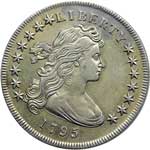 |
1795 Draped Bust Dollar B-14, BB-51 Rarity 2 Sharpness of AU. Cleaned, discolored, and possibly repaired. Still worth our conservative estimate for the details present. 1795 presents both the second year of silver dollar coinage in the United States as well as two major Types. The mint made a transition late in the year from the flowing hair style to the more mature draped bust of Liberty. The former small eagle was shrunken down even further for the true Small Eagle pieces of 1795-98. A scarce design which was in service for a few years only.
Estimated Value $2,500-UP.
View details and enlarged photos
| Realized
$4,370 |
Lot 2865 |
 |
1797. 9 x 7 Right, Small Letters B-2, BB-72 Rarity 4. NGC graded Fine-12. Fine adjustment marks appear on the obverse. Popular die combination that pairs the familiar Draped Bust form of Liberty on the obverse with the reduced usage Small Eagle reverse struck only in 1795 to 1798. Light even wear with plenty of eye appeal for the collector of 18th century US coins. Struck during the one-term Presidency of John Adams (1797-1801), having earlier served first as the Vice President under Washington, and whose son, John Quincy Adams became the 6th President (1825-29). An historic coin from a storied period in US history.
Estimated Value $3,300 - 3,600.
View details and enlarged photos
| Realized
$4,025 |
Lot 2866 |
 |
1797. 10x6 Stars B-3, BB-71 Rarity 3 PCGS graded Genuine XF Details. Cleaning. Harshly cleaned and untoned but still a very scarce Draped Bust, Small Eagle coin that always attracts fans of early American coins. The silver dollar is the most impressive of these, although all 1797-dated denominations are medium to very scarce. It has to be remember that at the time, the mint employed a hand-operated coining press to strike this. It was back-breaking, sweaty labor. Odd as it seems, mint workers were given a beer ration at the expense of the government. Not so odd, once one realizes that brewed beer was actually safer to drink than "fresh water" from a bacteria infested stream or well. Be that as it may, in 1797, no machine-powered presses (steam or otherwise) existed in the relatively poor and backward United States Mint. Though 1797 is the year England first applied a steam engine to a minting press to strike the famous cartwheel 2 pence coinage, steam-driven presses wouldn't come to the Philadelphia Mint until the late 1830s (PCGS # 6865) .
Estimated Value $3,500 - 4,000.
View details and enlarged photos
Check results on similar lots
| Realized
$4,025 |
Lot 2867 |
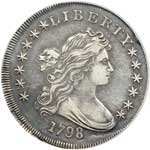 |
1798 Pointed 9 Close Date B-9, BB-121 Rarity 5. SEGS graded EF-40. Slightly misaligned dies. Excellent detail and lightly toned. We note a scratch in the left reverse field and a mark on the shield. Highly attractive toning. The rich antique gray fields provide an offset, as it were, for the lighter silver gray highlights of the raised devices. Large wide dentils along the left obverse, with narrowing of these along the right.
So-called "Amateur Diecutter's Reverse." Star distant from eagle's beak. Arc star pattern, but amateurishly executed, with the first star in the second row out of place and too high. This is the only 1798 reverse with this "sloppy" die work. Star distant from beak. Star ray points to top of I in PLURIBUS. Five small berries, the second and third from top are closest together. Bottom end of olive branch is long and needle like. Leaf points to lower right point of R in AMERICA. Either 12 or 13 arrows are present; two are very weak and appear to hold another stick between them; the two rightmost arrow shafts each have two heads (and thus count as four arrows), the third arrow shaft from the right is ghostlike (the three rightmost shafts are quite similar to those on the reverse used to coin BB-96, BB-101 and certain other reverses of the era). Reverse die used to strike 1798 BB-121 only.
According to the Bowers-Borckhardt reference, "1798 BB-121 has an estimated population of 300 to 500 pieces, enough that the specialist can find one with some searching…" Most specimens of BB-121 are seen in lower grade levels, however, with few noted in Extremely Fine and above. The variety becomes a rarity in AU grade and may be unknown in full Mint State, if today's strict grading interpretations are used.
Designs used: The year 1798 saw the number of obverse stars decreased from 16 (used in 1797) to 13, the number that remained in effect throughout the remainder of the series. An exception is provided by BB-81, with 15 stars, an anachronism created by using a leftover undated die prepared in 1795 or early 1796 (before the 16-star format became standard following the admission of Tennessee to the Union), and dating it 1798.
Estimated Value $3,200 - 3,500.
View details and enlarged photos
| Unsold |
Lot 2868 |
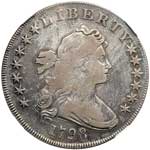 |
1798 Draped Bust Dollar. Large eagle. NGC graded Fine-15. Even gray toning. A transition occurs in 1798 from the earlier Small Eagle style, produced only in the earliest months of the year, to the more stately Heraldic style reverse with an eagle based on the one found on the Great Seal of the United States.
The Great Seal of the United States is used to authenticate certain documents issued by the United States federal government. The phrase is used both for the physical seal itself (which is kept by the United States Secretary of State), and more generally for the design impressed upon it. The Great Seal was first used publicly in 1782.
The obverse of the great seal is used as the national coat of arms of the United States. It is officially used on documents such as United States passports, military insignia, embassy placards, and various flags. As a coat of arms, the design has official colors; the physical Great Seal itself, as affixed to paper, is monochrome.
Since 1935, both sides of the Great Seal have appeared on the reverse of the one-dollar bill. The Seal of the President of the United States is directly based on the Great Seal, and its elements are used in numerous government agency and state seals.
Estimated Value $1,300 - 1,400.
View details and enlarged photos
| Realized
$1,553 |
Lot 2869 |
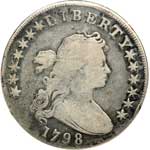 |
1798 Draped Bust Dollar. Large eagle. NGC graded VG-8. Evem wear on this toned specimen, medium to deep "old silver" gray around devices, lighter rubbed silver high points. Injury-free coins like this are a popular entry level purchase for the coin collector.
Estimated Value $800 - 850.
View details and enlarged photos
| Realized
$949 |
Lot 2870 |
 |
1798 B-21 BB-107 Rarity 5 Point 9 Large Eagle 10 Arrows. NGC graded EF-40. All of the main points on this well struck 1798 Large Eagle specimen are in line with its desirable grade. The field on the obverse is particularly smooth, light gray in color, and free of marks. The rims also bear evidence that they were uninjured through its two centuries of passage through time. In evaluating the reverse, we find a similar slew of positive attributes, consistent with the obverse and thereby improving things all the more. A Type Collector�s must-have specimen if what you are looking for is a representative Draped Bust Silver Dollar for your collection.
Estimated Value $3,000 - 3,200.
The Arden Collection.
View details and enlarged photos
| Realized
$3,393 |
Lot 2871 |
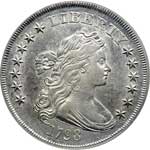 |
1798. Large Eagle Close Date B-25, BB-123 Rarity 4 PCGS graded Genuine AU Details. Cleaning. Untoned. Several obverse die breaks are noted. Very sharply made and carefully preserved from damage, despite any little cleaning it shows. A coin that will tone further in the years to come, it has plenty of eye apple for a collector seeking one of these large, impressive Draped Bust silver dollars from the 18th century (PCGS # 6873) .
Estimated Value $3,500 - 4,000.
View details and enlarged photos
Check results on similar lots
| Unsold |
Lot 2872 |
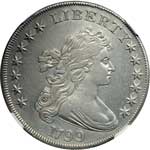 |
1799 B-16, BB-158 Normal Date 7x6 Stars Rarity 2 NGC graded AU Details. Improperly cleaned. Faint cleaning gives this coin a matte-like pale silver appearance. Nevertheless, all design features are well struck and present themselves to the viewer in proper fashion, nicely portraying the maker�s intent. There is a full E PLURIBUS UNUM clearly incised into the ribbon on the reverse, full horizontal and vertical shield lines and nice outline to the shield (unlike many where the edges merge into the eagle�s wings. Detailed feathers in wings and tail as well, though less evident on the breast. Perfect rims both sides.
Estimated Value $2,500 - 2,700.
View details and enlarged photos
| Unsold |
Lot 2873 |
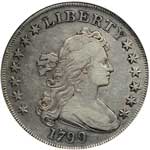 |
1799 B-14, BB-167 Rarity 3. NGC graded EF-40. Subset of PCGS # 40043. Probably cleaned long ago. A pleasing example, light silver gray in color. The surface commends itself to the collector since the absence of marks of any note are, well, noteworthy. Choice rims encircle the design. The deeper recesses show darker antique silver patina as the coin slowly returns to its natural "toned silver" state.
Estimated Value $2,300 - 2,400.
The Arden Collection.
View details and enlarged photos
| Realized
$3,393 |
Lot 2874 |
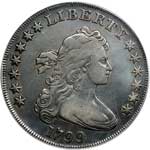 |
1799 $1 B-12 BB-160 Rarity 3. PCGS graded VF-25. Even dark grey toning. With attractive detail in all areas, this well centered, adequately struck example represents the Large Eagle issue struck from 1798 to 1803. Die breaks below 17 of date and between end of bust and last star (PCGS # 6878) .
Estimated Value $1,500 - 1,600.
View details and enlarged photos
Check results on similar lots
| Realized
$1,955 |
Lot 2875 |
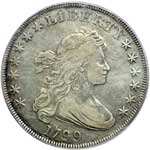 |
1799 B-11, BB-161 Rarity 3. PCGS Genuine. Cleaned. Our grade is Sharpness of Very Fine, lightly toned (PCGS # 6878) .
Estimated Value $650 - 700.
View details and enlarged photos
Check results on similar lots
| Realized
$1,265 |
Lot 2876 |
 |
1800 B-2, BB-182 Normal Date Rarity 6 NGC graded AU Details. Obverse tooled. Nice and sharp but an area around the neck looks repaired. Lightly toned.
Estimated Value $2,000 - 2,200.
View details and enlarged photos
| Realized
$3,335 |
Lot 2877 |
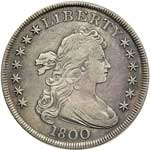 |
1800 Normal Date B-8, BB-188 Rarity 4 Sharpness of VF30. Possibly lightly cleaned long ago. Even antique grey toning blankets both sides. Quite attractive.
Estimated Value $1,900 - 2,100.
View details and enlarged photos
| Realized
$1,725 |
Lot 2878 |
 |
1800 Normal Date B-13, BB-193 Rarity 4 PCGS graded Genuine VF Details. Cleaned, with resulting hairlines. Given a certain amount of time, this will continue to tone. As the underlying devices and surface is pleasing otherwise, it should present an attractive appearance (PCGS # 6887) .
Estimated Value $900 - 1,000.
View details and enlarged photos
Check results on similar lots
| Realized
$1,438 |
Lot 2879 |
 |
1800. B-4, BB-186 Rarity 4. PCI graded VG-10. Well worn but amazingly free from bumps and bad scratches. Our grade is Good 5.
Estimated Value $500 - 550.
View details and enlarged photos
| Realized
$748 |
Lot 2880 |
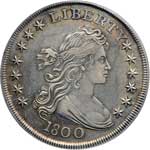 |
1800. "AMERICAI" B-19, BB-192 Rarity 2 PCGS graded Genuine XF Details. Cleaning. Well struck with sharp details throughout. Nice clean planchet and not harshly cleaned. Lightly toned and darkening naturally around the devices. It is believed a slip of the die maker's engraving tool cause a depressed scrape in the die somewhat reminiscent of a letter punch "I" but without serifs. This variety, a Red Book variety, has come down to us as the AMERICAI variety due to the error's location at the end of the word (PCGS # 6892) .
Estimated Value $3,000 - 3,300.
View details and enlarged photos
Check results on similar lots
| Realized
$3,680 |
Lot 2881 |
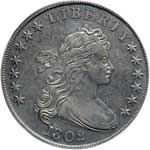 |
1802 Narrow Date B-6, BB-241 Rarity 1 PCGS graded Genuine AU Details. Questionable color. Very well struck with full hair detail. Uniform greyish-violet toning on both sides. A very handsome Bust Dollar struck near the end of the series. All hair waves are plainly visible including the small curl on Liberty's neck which tended to be weak on some coins. Liberty's hair is tied at the back with a trailing ribbon as though blowing in the wind, a nice artistic touch. The eagle with shield motif, modeled on the Seal of the United States, is itself the height of fine detail and boldness. No denomination appears on the face of the coin, but it is inscribed (in a separate mechanical process before the blank planchet is struck) on the coin's edge. In later coinage, that of the 1830s to the present, edge lettering would give way to milling or "reeds" as they are called, as in reeded edge. This has the former lettered edge, which is unavailable for viewing due to the presence of the grading holder, an unfortunate result of third-party grading adoption (PCGS # 40087) .
Estimated Value $4,500 - 5,000.
View details and enlarged photos
Check results on similar lots
| Realized
$4,370 |
Lot 2882 |
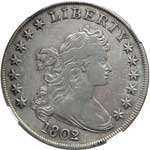 |
1802/1 B-4, BB-232 Close Date Rarity 4 NGC graded VF Details. Improperly cleaned. Struck on a problem-free planchet. Uniform light greyish violet toning. Much to the admiration of collectors, the overdate on the 1802, 2 over 1 dollar is clearly visible. This specimen has clear, bold devices on the reverse, including full motto on the ribbon which the eagle has in its beak. Strong shield.
In heraldry, the US shield is composed of the blue Chief (top horizontal bars) and the red and white Pales (thirteen vertical stripes, seven red background bars with six bands of raised lines representing the white) which represent the several states all joined in one solid compact entire, supporting a Chief which unites the whole and represents Congress. The motto E PLURIBUS UNUM alludes to this union.
The stripes are kept closely united by the Chief, and the Chief depends upon the union and the strength resulting from it for its support to denote the Confederacy of the United States of America and the preservation of their union through Congress.
Estimated Value $1,500 - 1,600.
View details and enlarged photos
| Unsold |
Lot 2883 |
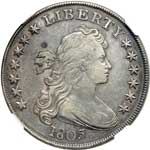 |
1803 Small 3 B-5, BB-252 Rarity 3. NGC graded EF-45. Pleasing surfaces and lightly toned. We note a natural toning spot behind the head, otherwise light silver-gray patina throughout, the obvious result of silver aging through more than two centuries of time. Slight weakness as struck on the upper hair, the curl or "lovelock" as it is called on the neck, and in the shoulder area; traces of the same minor weakness can be found on the reverse. Still highly presentable. Final year of the Type. The 1804 issues were minted years later from back-dated dies, so that most collectors who aren't Kings or wealthy Oligarchs can ignore the 1804 as an outlier when assembling a date set of these handsome large coins, 1794 to 1803.
Estimated Value $4,000 - 4,500.
View details and enlarged photos
| Unsold |
Lot 2884 |
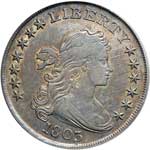 |
1803. Large 3 B-6, BB-255 Rarity 2. PCGS graded EF-45. A lovely, problem free specimen, exhibiting golden and violet hues in lightly striated fashion with smooth surface, outstanding rims. For eye appeal and affordable grade, this EF 45 example is highly presentable (PCGS # 6901) .
Estimated Value $4,000 - 4,500.
View details and enlarged photos
Check results on similar lots
| Realized
$5,463 |
|
|